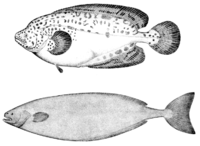Ragfish
| Ragfish | |
|---|---|

| |
| Juvenile (top) and adult | |
| Scientific classification | |
| Kingdom: | |
| Phylum: | |
| Class: | |
| Order: | |
| Family: | Icosteidae
|
| Genus: | Icosteus
|
| Species: | I. aenigmaticus
|
| Binomial name | |
| Icosteus aenigmaticus Lockington, 1880
| |
The ragfish, Icosteus aenigmaticus, is an odd ray-finned fish of the northern Pacific Ocean; although a perciform, its skeleton is mostly cartilage, and the larvae have pelvic fins that disappear as they mature. It is the sole member of the family Icosteidae, and some authorities place it into its own order Icosteiformes. It was first described by W. N. Lockington in 1880.
The ragfish body is scaleless and limp, both because of the cartilaginous skeleton, as well as its flabby muscles. None of the fins have any spines. The dorsal and anal fins extend much of the length of the body, while the pelvic fins are absent. The coloration is generally a dark brown, and maximum known length is two meters.
Ragfishes are found in deeper waters out to sea, and are said to eat other fish, squid, and octopus, although recent catches show no squid beaks but large amounts of jellyfish.
The larvae make a remarkable transformation as they mature; the caudal fin shrinks, and the pelvic fins disappear.
It was considered formerly that adult ragfishes were different species, known then as Acrotus willoughbyi.[1]
References
- "Icosteus aenigmaticus". Integrated Taxonomic Information System. Retrieved 19 March 2006.
